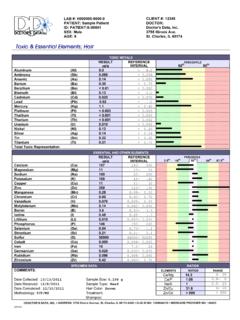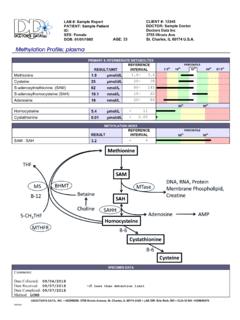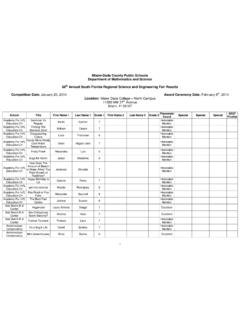Transcription of DNA Methylation Pathway Profile; Blood Spot
1 LAB #: B000000-0000-0 PATIENT: Sample PatientID: PATIENT-S-00000 SEX: FemaleAGE: 5 CLIENT #: 12345 DOCTOR: Doctor's Data, Illinois Charles, IL 60174, !DNA Methylation Pathway Profile; Blood SpotRESULTSM utationMutation(s)Gene Name / VariationNot PresentPresentCallSHMT / C1420T+/+AAHCY / 1-/-AAHCY / 2-/-TAHCY / 19-/-AMTHFR / C677T-/-CMTHFR / A1298C-/-AMTHFR / 3-/-CMTR / A2756G+/-HeteroMTRR / A66G-/-AMTRR / H595Y+/-HeteroMTRR / K350A+/-HeteroMTRR / R415T-/-CMTRR / S257T-/-TMTRR / 11-/-GBHMT / 1-/-ABHMT / 2-/-CBHMT / 4+/-HeteroBHMT / 8+/+TCBS / C699T+/-HeteroCBS / A360A+/-HeteroCBS / N212N-/-CCOMT / V158M+/-HeteroCOMT / H62H+/-HeteroCOMT / 61-/-GSUOX / S370S-/-CVDR / Taq1+/+TVDR / Fok1-/-CMAO A / R297R+/-HeteroNOS / D298E+/-HeteroACAT / 1-02-/-GComments: Date Collected: 06/14/2015*For Research Use Only. Not for use in diagnostic Received: 06/17/2015 Date Completed: 07/03/2015 Methodology: MassARRAY iPLEXT platform by Sequenom DOCTOR S DATA, INC.
2 !!!! ADDRESS: 3755 Illinois Avenue, St. Charles, IL 60174-2420 !!!! CLIA ID NO: 14D0646470 !!!! MEDICARE PROVIDER NO: 148453 Analyzed by Bioserve Biotechnologies, 9000 Virginia Manor Road, Suite 207, Beltsville, MD 207050001867 Minus - represents no mutationPlus + represents a mutation -/- indicates there is no mutation +/- indicates there is one mutation +/+ indicates there is a double mutationMethionine Metabolism Transmethylation & Transsulfuration DiagramLab number: B000000-0000-0 DNA Methylatn BldSpt Page: 1 Patient: Sample Patient Client: 12345 IntroductionSingle nucleotide polymorphisms (SNPs) are DNA sequence variations, which may occur frequently in the population (at least one percent of the population.) They are different from disease mutations, which are very rare.
3 Huntington s disease is an example of a disease mutation- if you inherit the altered gene, the disease will develop. Certain SNPs may be associated with particular health conditions, but they are not known to cause disease. The majority of SNPs in this report affect protein, enzyme or cell receptor structure or function. Some SNPs may have modest and subtle but true biological effects and have been correlated with health concerns or disease risk. Their abundance in the human genome as well as their higher frequencies in the human population have made them targets to help explain variation in risk of common diseases. Often multiple SNPs need to be present to alter metabolic or biochemical functions in the body. SNPs and gene expression may often be modified by epigenetic factors (diet, lifestyle, nutrition, toxicant exposures). The influence of a single SNP may vary widely: for example, a specific SNP in MTHFR may influence enzyme function from 30-60%.
4 In contrast, the SNP with the greatest known effect on human height only accounts for percent of height are classified as homozygous (+/+) for the variant if they carry 2 mutated alleles, heterozygous (+/-) if they carry only one mutated allele, and homozygous (-/-) for the wild type gene if they have no mutant alleles. This panel of SNPs provides information about many facets of health and wellness, with an emphasis on important biochemical processes such as methionine metabolism (see diagram on the preceding page), detoxification, hormone and neurotransmitter balance, and Vitamin D function. It is emphasized that SNPs are not imminently associated with abnormal metabolism or disease conditions. The presence or absence of a reported SNP is not the sole determinant of physiological function; it is simply one potential contributing factor.
5 The results presented in this report should be interpreted in context with symptoms, epigenetic factors and other laboratory findings. SHMT/ C1420T (Serine hydroxymethyltransferase)Pathways/bioche mistrySerine hydroxymethyltransferase (SHMT) catalyzes the inter-conversion of serine and glycine, which has a role in neurotransmitter synthesis and metabolism and, moderates the activity of S-adenosyl methionine (SAM) synthesis. SHMT converts tetrahydrofolate into 5,10-methylene tetrahydrofolate. Folate-dependent one-carbon metabolism is critical for the synthesis of numerous cellular constituents required for cell growth, and SHMT is central to this process. Vitamin B-6 is an obligatory cofactor for SHMT activity. Possible Health Implications SHMT polymorphisms may disrupt cellular function leading to increased DNA damage, alterations in folate distribution for Methylation reactions (inhibition of Methylation ), and competition with MTHFR.
6 When 1999-2015 Doctor s Data, number: B000000-0000-0 DNA Methylatn BldSpt Page: 2 Patient: Sample Patient Client: 12345combined with MTHFR SNPs, SHMT SNPs may be associated with elevated plasma homocysteine which increases risk for cardiovascular disease, stroke, vascular dementia, and Alzheimer s disease; these cumulative effects are dependent on B-vitamin and folate status. The maternal risk for Down s Syndrome is also altered with the SHMT mutation; the CC genotype is C1420 T genotypes may generally be considered protective for cancers, however the homozygous (TT) genotype may increase risk for colorectal cancers in cases of folate deficiency. The cancer protective effects of CT/TT genotypes may prove to be folate-dependent; research is ongoing. There is evidence that both SHMT/ C1420T and MTRR/ A66G polymorphisms may decrease risk for general, homozygotes are more influenced by SNPs than to optimize the phenotypeEnsure adequate B-12, folate, betaine and B-6 to support Methylation pathways.
7 Monitor homocysteine levels and Methylation pathways. Minimize cancer risks through lifestyle , Lynn B. Ed. (15 June 2009) Folate in Health and Disease, Second Edition. CRC Press. Hebbring, Scott J. et al. (2012) Serine hydroxymethyltransferase 1 and 2: gene sequence variation and functional genomic characterization. J Neurochem 120(6):881-90, PMID 22220685. Accessed 11/06/2012 Herbig K, Chiang EP, Lee LR, Hills J, Shane B, Stover PJ. (2002 Oct 11) Cytoplasmic serine hydroxymethyltransferase mediates competition between folate-dependent deoxyribonucleotide and S-adenosylmethionine biosyntheses. J Biol Chem.;277(41):38381-9. Accessed 11/05/2012 Marucci , GH. et al. (2012) Polymorphism C1420T of Serine hydroxymethyltransferase gene on maternal risk for Down syndrome. Mol Biol Rep. Mar;39(3):2561-6. Accessed 11/05/2012 NS, Jain JM, Chintakindi KP, Singh RP, Naik U, Akella RR.
8 (2009) Aberrations in folate metabolic Pathway and altered susceptibility to autism. Psychiatr Genet. Aug;19(4):171-6. Accessed 11/06/2012 Guerreiro, Catarina et al. (2008) Risk of colorectal cancer associated with the C677T polymorphism in 5,10-methylenetetrahydrofolate reductase in Portuguese patients depends on the intake of methyl-donor nutrients. Am J Clin Nutr November vol. 88 no. 5 1413-1418. Accessed 11/05/2012 OMIM Online Mendelian Inheritance in Man. SHMT Accessed 16 July 2013 MTR/A2756G (methionine synthase)Pathways/biochemistry 1999-2015 Doctor s Data, number: B000000-0000-0 DNA Methylatn BldSpt Page: 3 Patient: Sample Patient Client: 12345 Methionine synthase (MTR) catalyzes the re- Methylation of homocystiene to methionine utilizing methylcobalamin (methyl B-12) as a cofactor.
9 Important in folate metabolism, MTR maintains intracellular levels of methionine which is the precursor to S-adenosylmethionine (SAM). SAM is a vital methyl group donor involved in hundreds of Methylation reactions, including Methylation of DNA. Studies indicate that methionine synthase reductase (MTRR) may be required as a molecular chaperone for proper MTR Health Implications Under- or over- Methylation of the DNA for tumor suppressor or promoter genes may contribute to the selective growth or transformation of cells. Approximately 50% of cancer cells types are methionine dependent; low MTR function, while increasing plasma homocysteine levels, would decrease available methionine; this may influence cancer risk and tumor MTR/A2756G polymorphism has been associated with increased maternal risk of neural tube defect; the risk increases with the number of high-risk alleles, and may be cumulative with MTHFR polymorphisms.
10 The risk of hyperhomocysteinuria is also increased. A plasma homocysteine level greater than 14 mol/L is associated with increased risk of Alzheimer s is associated with male infertility and, it is more prevalent in patients with Celiac Disease. The SNP is generally cancer-protective (GI tract, lymphomas), and may be protective against dementia in the AG or GG genotypes; this protection may be population-specific to those of European descent and the reverse may be true of Asian populations. The AG/GG phenotype is associated with folate-deficient hypertension in Chinese males and, with increased risk of Inflammatory Bowel Disease in Asians. Genotypic/Phenotypic expressionThere is mounting evidence that, especially within the folate and Methylation pathways, multiple SNPs in multiple genes (haplotypes) and/or low folate or B-vitamin status are necessary to alter metabolism or change health outcomes.










